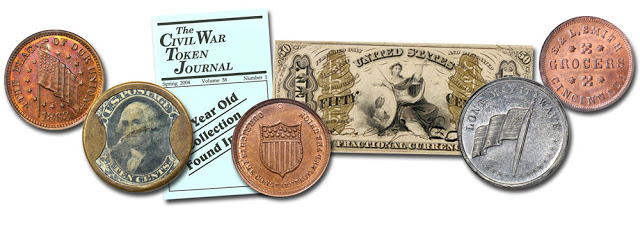
By definition, Civil War tokens are substitute money, not federal issues, coined privately during the Civil War period from April 1861 to April 1865. Most of them are dated 1863. If you are a student of American monetary history you know that beginning in December 1861, when the outcome of the war was uncertain, gold coins began to be hoarded and were no longer available at face value. By spring 1862 when Legal Tender Notes were not payable in silver or gold coins, concern increased and silver pieces were withdrawn from circulation. The icing on the cake was the second week of July in 1862, when even the copper-nickel Flying Eagle and Indian cents disappeared. For the first time in American history, and without a repetition since then, we had a completely coinless society! It was not possible to buy a glass of soda, have a haircut, get the latest newspaper, take a coach ride, or do much else.
Almost immediately the government jumped into action as did hundreds of private businesses and localities. On July 17 the Treasury Department made ordinary postage stamps legal tender! A flood of paper scrip notes with printed values such as three cents, five cents, 10 cents, 25 cents and 50 cents appeared, issued by hotels, railroads, saloons, and other businesses, and redeemable in such locations. In a given town these notes were interchangeable throughout commerce, so long as they were imprinted with the name of a business that would eventually redeem them. This worked quite well.
On August 12, the encased postage stamp was patented by John Gault. Over 30 different businesses used these to advertise. These consisted of a brass frame housing a postage stamp visible through clear mica on the face, and with a commercial message on the back. The number of these circulated is not known, but was probably in the millions. Today they are avidly collected.
Returning to the Civil War tokens, most of these were made of bronze and about the size of a federal cent. Bronze was a softer metal and easier to strike, and was less expensive to produce. In 1862, increasing to a flood in 1863, tens of millions of dollars of these tokens were circulated. As my new book explains, these were divided into two categories. Patriotic tokens depicted the American flag, cannon, ships, Indian heads and the like, with inscriptions such as UNION FOREVER, ARMY & NAVY, and so on. These did not bear the name of any issuer. The second category was that of store cards, which on the obverse had an advertisement for a business, product or service, and on the reverse a design such as a Liberty head, Indian head, eagle or something else. Nearly 1,000 different businesses issued these.
Today Civil War tokens are enthusiastically collected. The Civil War Token Society publishes the Civil War Token Society Journal and is well worth investigating. Check their internet site. The field of such tokens has much potential, as great rarities can be obtained for nominal prices. Beautiful Mint State examples of coins of which fewer than a couple dozen are known can be bought in some instances for less than $100, and in other instances for just slightly more. A modest budget goes a long way. Beyond that, each token has an interesting story to tell.
Creating the Guide Book was a fascinating project and involved many helpers. Watch for announcements as soon as it becomes available!





